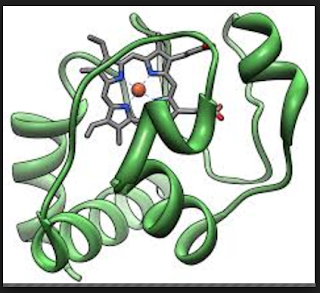Cytochrome c
The cytochrome complex or
cyt c is a small heme protein found loosely associated with the inner membrane
of the mitochondrion. It belongs to the cytochrome c family of protein.
Heme Protein
Protein that contain heme prosthetic group.Heme is bound to the protein either covalently or noncovalently bound or both.
Distribution
Cytochrome c is highly
soluble, unlike other cytochrome, and is an essential component of the etc
.Cytochrome c is a highly conserved protein across the spectrum of species,
found in plant, animals and many unicellular organisms. This along with its
small size (weight 12,000 Daltons).It
primary structure consists of a chain of
about 100 amino acids ,and the higher-
order organism possess a chain of 104 amino acids.
There are many function
of cytochrome c.
1.
In electron
transport chain.
2.
Role in apoptosis
3.
As anti-oxidative
enzyme.
·
Role in ELECTRON TRANSPORT CHAIN
Cytochrome c oxidize is
the last enzyme in the respiratory electron transport change of mitochondria. Its
main function is convert molecular oxygen to water and aid in establishing
mitochondrial membrane potential.
It is locates the inner
membrane which separates the mitochondrial matrix from the intercellular space.
The heme group of
cytochrome c accepts electrons from the3 bc1 complex and transfers electrons to
the complex IV.
·
Role in Apoptosis
One of the ways cell
apoptosis is activated is by release of cytochrome c from the mitochondria in
the cytosol.
According to the research that
cells are to able to protect from apoptosis by blocking the release of cytochrome C using BCL-xl. .
Another way the cell can
control apoptosis is by phosphorylation, which turn chytochrome c into an anti- apoptosis switch.
·
As Anti-Oxidative
Enzyme:
Cytochrome c is known to
play a role in the electron transport chain cell apoptosis,
Recent study shown that
it can also acts as an anti-oxidative enzyme in mitochondria and it does so by
removing superoxide and hydrogen peroxide from mitochondria, therefore, not
only is cytochrome c required in mitochondria for cell respiration, but it is also
needed in the mitochondria to limit the production of superoxide and hydrogen
peroxide.










No comments:
Post a Comment